New to Sly Flourish? Start Here or subscribe to the newsletter.
2024 DMG Versus the Lazy Encounter Benchmark
by Mike on 29 October 2023
This article compares the encounter building rules in the new D&D 2024 Dungeon Master's Guide (DMG) to the Lazy Encounter Benchmark – my tool for helping GMs quickly benchmark 5e encounters to determine potential deadliness.
Here's a quick summary of my conclusions:
- The D&D 2024 rules for encounter building are far improved from the convoluted and inaccurate rules in the 2014 Dungeon Master's Guide.
- The D&D 2024 encounter building rules match up well with the Lazy Encounter Benchmark. They're close enough in most areas that you can use which ever you prefer.
- The 2024 DMG rules produces particularly dangerous encounters when pitting a higher number of low CR monsters against the characters.
- The 2024 DMG rules overvalues high-CR monsters – making it harder to add more monsters to defend your bosses.
- I still prefer the Lazy Encounter Benchmark. You can memorize it and it helps you quickly benchmark combat encounters during play letting you improvise combat encounters.
The Lazy Encounter Benchmark
I've spent a lot of time thinking about combat encounter building in 5th edition D&D and now other 5e variants such as Level Up Advanced 5e and Tales of the Valiant. I tried many different approaches and finally came to the Lazy Encounter Benchmark.
The Lazy Encounter Benchmark can be summarized as follows:
- Build combat encounters from the story and situation in the game.
- If needed, check to see if this encounter may be unexpectedly deadly.
An encounter may be deadly if the total of monster challenge ratings is greater than one quarter of total character levels, or half of character levels if they're above 4th level.
A single monster may be deadly if it's challenge rating is greater than the average character level of the group, or if it's greater than 1.5x the average character level if they're above 4th level.
To determine your deadly encounter benchmark add up all the levels of all the characters in your group and divide by 4 if they're 1st to 4th level or divide by 2 if they're 5th to 20th level.
We have a detailed definition of what "deadly" means in Forge of Foes, but I'll simplify it to "characters could die".
You can write that number down in your notes if you need to, along with the CR benchmark for a single monster which is either equal to the characters' average level or 1.5 x their average character level if they're 5th level or above.
This benchmark is a loose gauge, not a hard rule. Different circumstances affect a battle's difficulty beyond just character level and monster challenge rating, but it's a great easy benchmark to help GMs loosely gauge encounter difficulty.
The "Hard" Version of the Lazy Encounter Benchmark
Sometimes, at 11th level and above, characters have serious firepower available and the Lazy Encounter Benchmark no longer identifies a potentially deadly encounter. For this, I've added an optional benchmark increase at 11th level and 17th level:
At 11th level, an encounter may be deadly if the total of monster challenge ratings is greater than 3/4ths of total character levels or equal to total character levels if they're 17th level or above.
This benchmark is very close to the one come up by Paul Hughes in Level Up Advanced 5e's Monstrous Menagerie and you can find variants of it in Forge of Foes, the Lazy DM's Companion, the Tales of the Valiant Gamemaster's Guide, and MCDM's Flee Mortals.
Using the 2024 DMG Encounter Building Guidelines
The 2024 Dungeon Master's Guide has a much-easier process for determining encounter balance than the 2014 DMG. With this new process you:
- Determine a difficulty of easy, medium, or hard.
- Determine your experience point budget based on the number of characters, the level of those characters, and the difficulty of the encounter you're aiming for.
- Select monsters with an experience point total less than the experience budget you calculated in step 2.
Understanding the Experience Point to CR Curve
Because the D&D 2024 Dungeon Master's Guide uses experience points instead of challenge ratings as a budget, it's important to understand how the two numbers relate.
Experience points increase exponentially with challenge rating. The CR of a CR 8 monster is only double that of a CR 4 monster, but the CR 8 monster's experience value of 3,900 is 3.5x more than that of the CR 4 monster's 1,100 experience point value.
Because experience points are on an exponential curve compared to challenge rating, the total challenge ratings you can use for an encounter based on this chart goes down as the challenge ratings of individual monsters goes up. The lower the challenge ratings of the monsters you include in a battle, the greater the increase in the number of monsters you can include in that battle.
Here's a table based on the D&D 2024 Dungeon Master's Guide converting experience points to challenge ratings based on the ratio of monsters to characters or characters to monsters. You might notice that this table is similar to the encounter building tables included in Xanathar's Guide to Everything.
| 2024 D&D DMG Hard XP to CR (Monsters per PCs) | |||||
|---|---|---|---|---|---|
| PC Level | 2 Mon per PC | 1 Mon per PC | 1 Mon per 2 PCs | 1 Mon per 4 PCs | 1 Mon per 6 PCs |
| 1 | 0.25 | .5 | 1 | 1 | 2 |
| 2 | 0.5 | 1 | 1 | 3 | 4 |
| 3 | 1 | 1 | 3 | 4 | 6 |
| 4 | 1 | 2 | 3 | 5 | 7 |
| 5 | 2 | 4 | 5 | 8 | 10 |
| 6 | 3 | 4 | 6 | 9 | 12 |
| 7 | 3 | 4 | 7 | 10 | 13 |
| 8 | 3 | 5 | 8 | 12 | 14 |
| 9 | 4 | 6 | 9 | 13 | 16 |
| 10 | 4 | 7 | 9 | 14 | 17 |
| 11 | 5 | 8 | 11 | 16 | 19 |
| 12 | 6 | 8 | 12 | 17 | 20 |
| 13 | 6 | 9 | 13 | 18 | 20 |
| 14 | 7 | 10 | 14 | 19 | 21 |
| 15 | 8 | 11 | 16 | 20 | 22 |
| 16 | 8 | 12 | 17 | 21 | 23 |
| 17 | 9 | 14 | 19 | 22 | 24 |
| 18 | 10 | 15 | 20 | 23 | 25 |
| 19 | 12 | 16 | 21 | 24 | 27 |
| 20 | 13 | 19 | 22 | 25 | 28 |
Comparing the Lazy Benchmark to the 2024 DMG "Hard" Encounter Building Table
The following charts show the relationship between monster challenge ratings and character levels given a ratio of monsters to characters. This includes the 2024 D&D Dungeon Master's Guide experience point budget for a "hard" encounter converted to challenge ratings compared to the challenge ratings of the Lazy Encounter Benchmark.
Each chart include two Lazy Benchmarks – one for the "normal" Lazy Encounter Benchmark and one for the "hard" benchmark based on 3/4 of total character levels at 11th level and above or equal to total character levels at 17th and above.
2 Monsters per Character
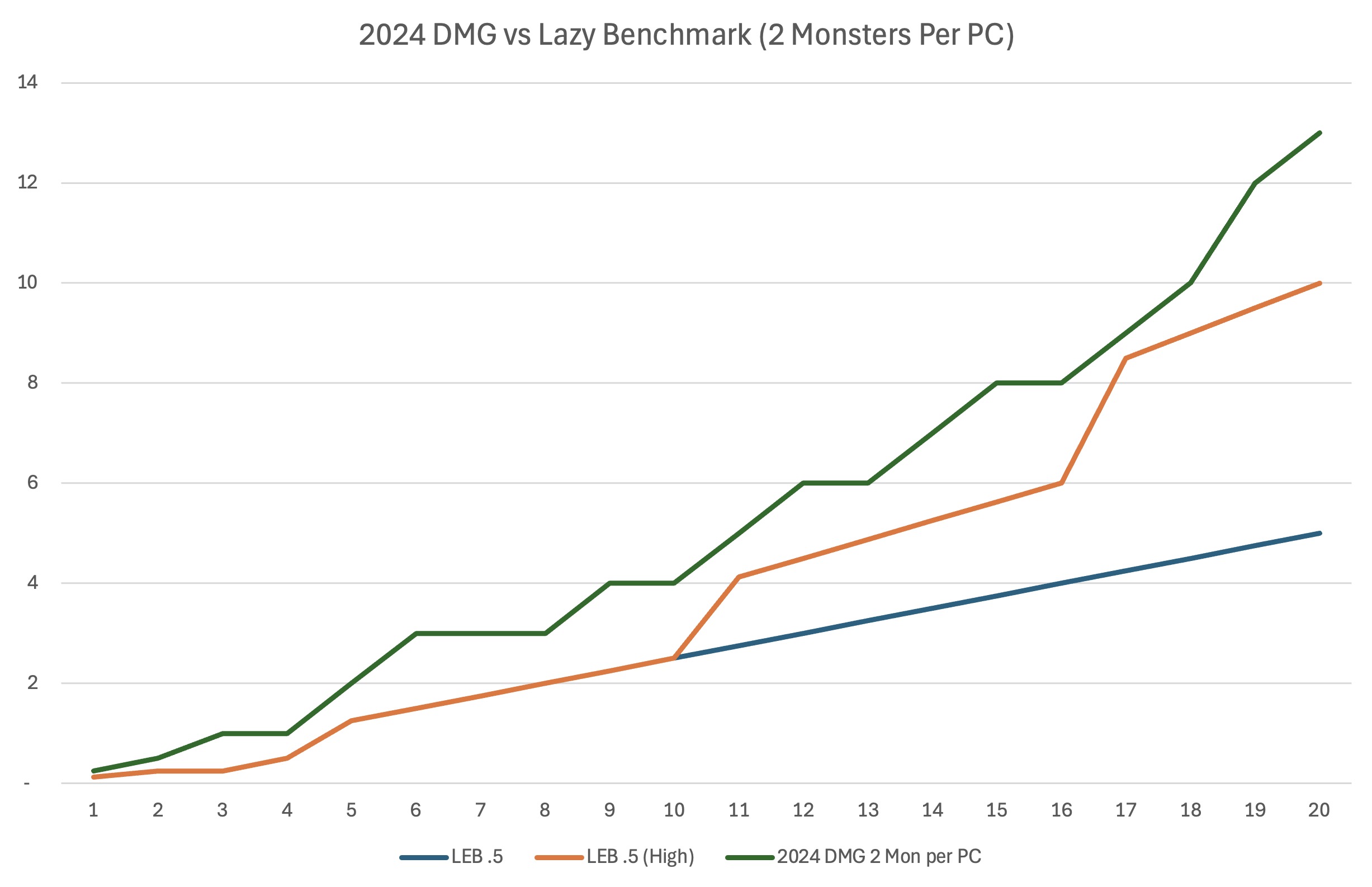
For 2 monsters per character, the DMG benchmark scales much higher than the Lazy Encounter Benchmark. Even when we use the "hard" benchmark at 11th level and above, the Lazy Encounter Benchmark still trails behind the D&D 2024 rules for a higher number of low challenge monsters.
This looks way too hard for me. For example, if you have four 3rd level characters, this guideline pits them against six CR 1 lions which have pack tactics, have +5 to hit, and hit for 14 damage. That feels deadly to me.
1 Monster per Character
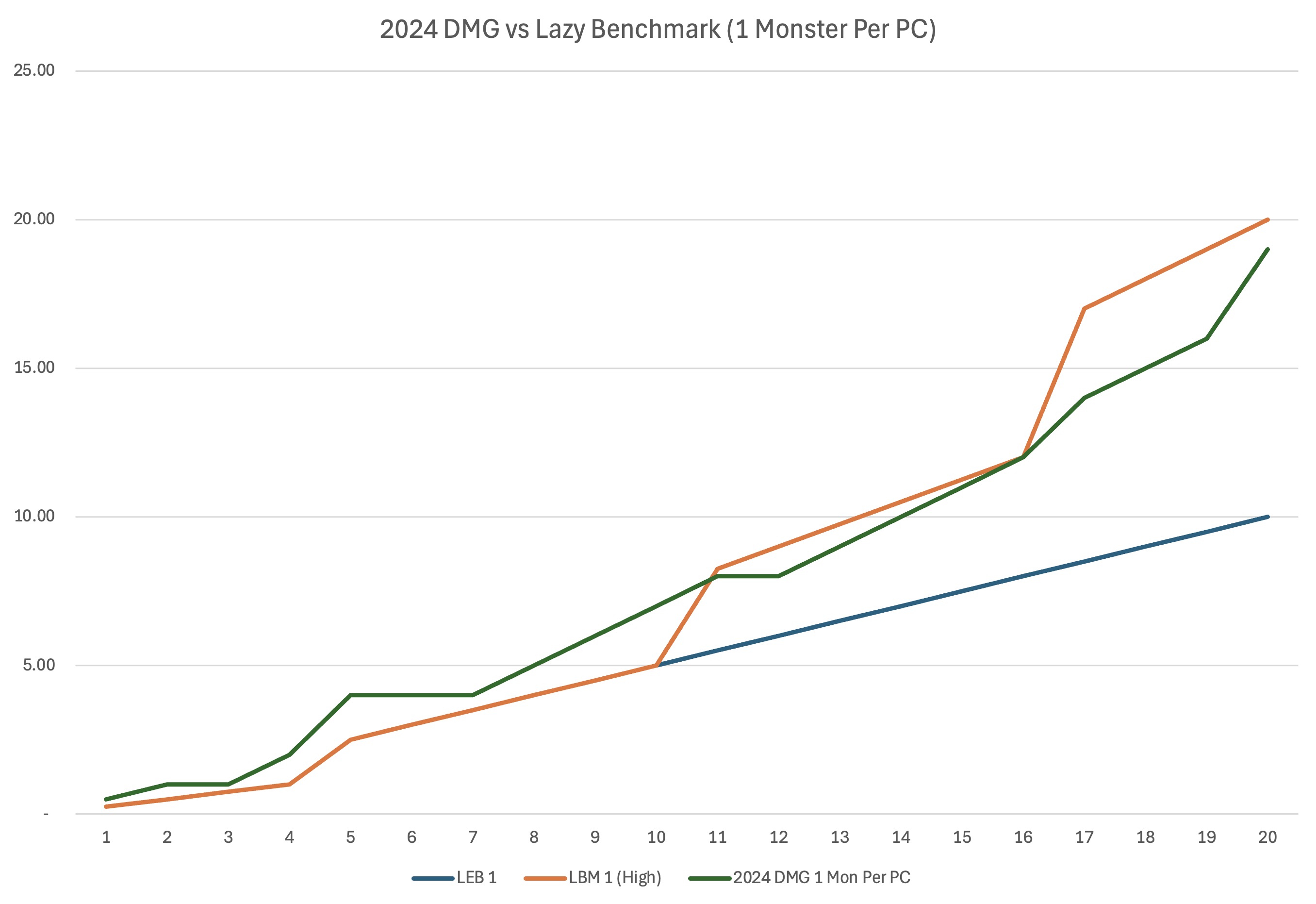
When we use the "hard" benchmark, the Lazy Encounter Benchmark is almost perfectly aligned to the D&D 2024 "hard" experience point budget. Keep in mind, the Lazy Encounter "Hard" Benchmark is really hard. That's why we kept it optional.
1 Monster per 2 Characters
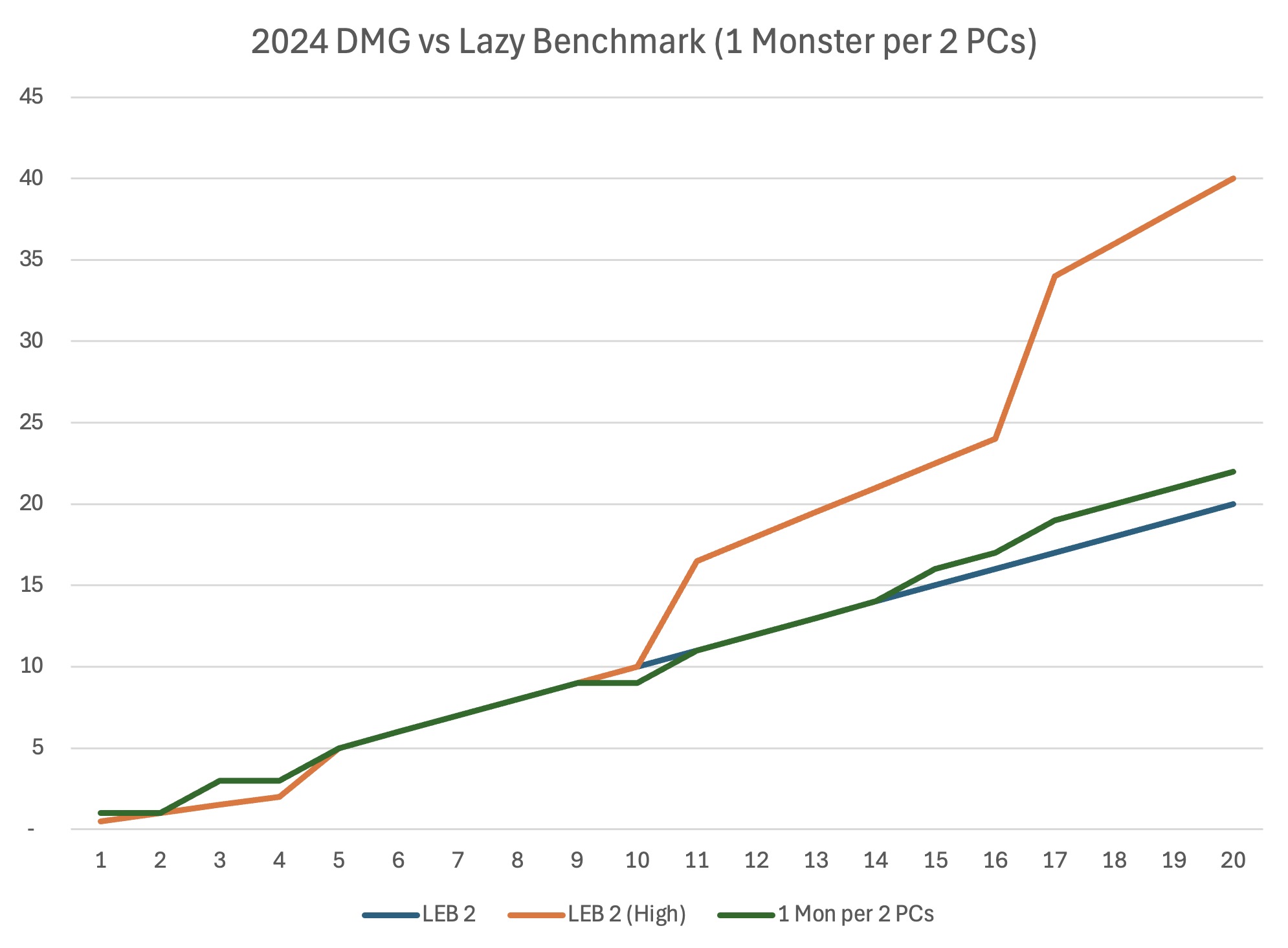
With one monster per two characters, the 2024 DMG "hard" budget matches almost perfectly with the "normal" Lazy Encounter Benchmark. If we use the "hard" benchmark for the Lazy Encounter Benchmark, it's way higher than the 2024 DMG one.
1 Monster per 4 Characters
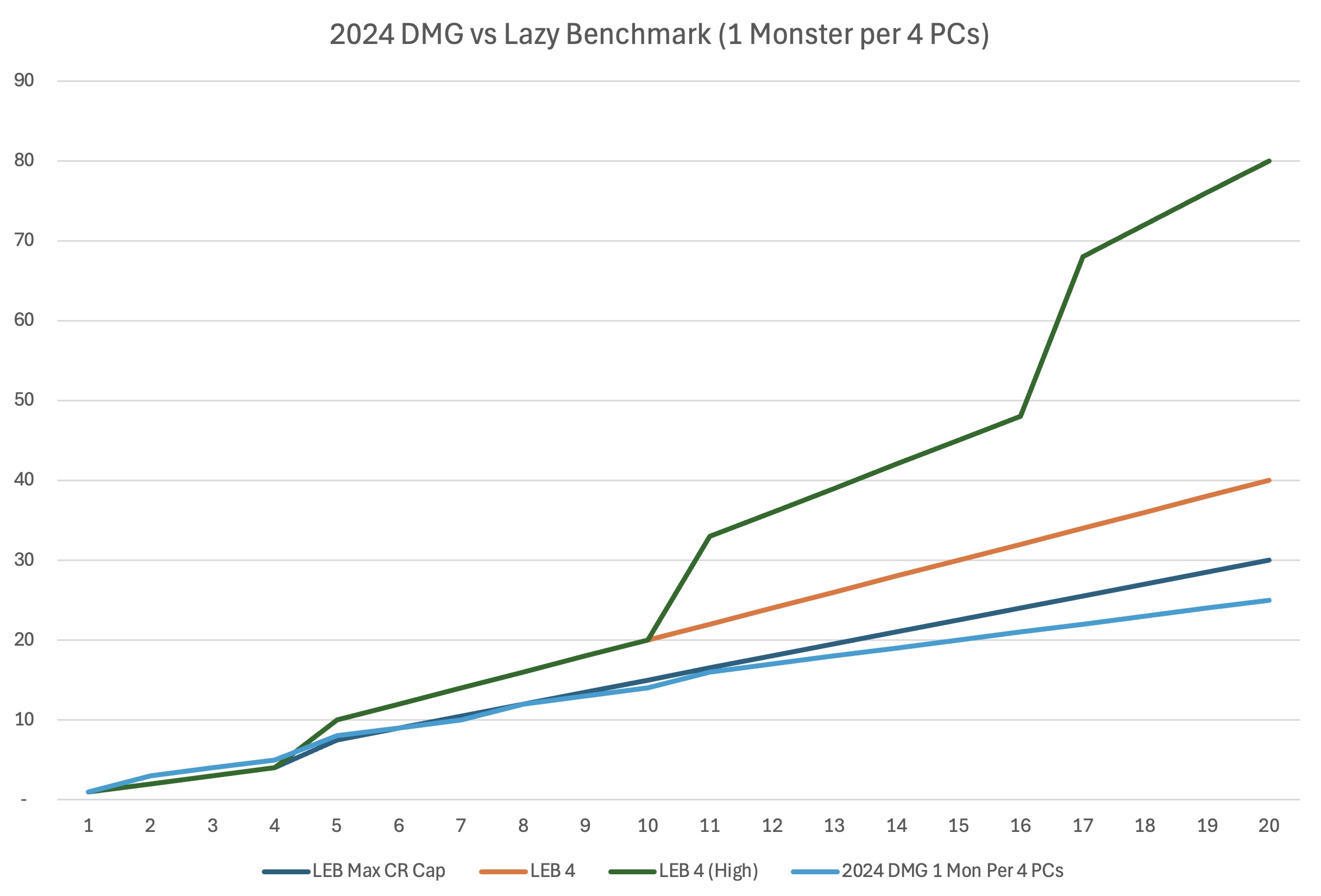
When we switch to a single monster for four characters, the Lazy Benchmark pulls higher, even in "normal" mode. When we use the "hard" mode, it's way high (80 CRs instead of 25 CRs at level 20)
This table also includes a line for the maximum challenge rating of a single monster according to the Lazy Benchmark which is equal to average character level or 1.5 x average character level at 5th level and above. This line matches almost perfectly to the "hard" experience budget of the 2024 DMG.
The Lazy Encounter Benchmark accounts for having a single big monster with a hard cap and allows for more lieutenant or minion monsters to protect that big boss. The D&D 2024 DMG encounter guidelines do not. I think single big CR monsters are going to die fast in 2024 D&D playing with these guidelines.
1 Monster per 6 Characters
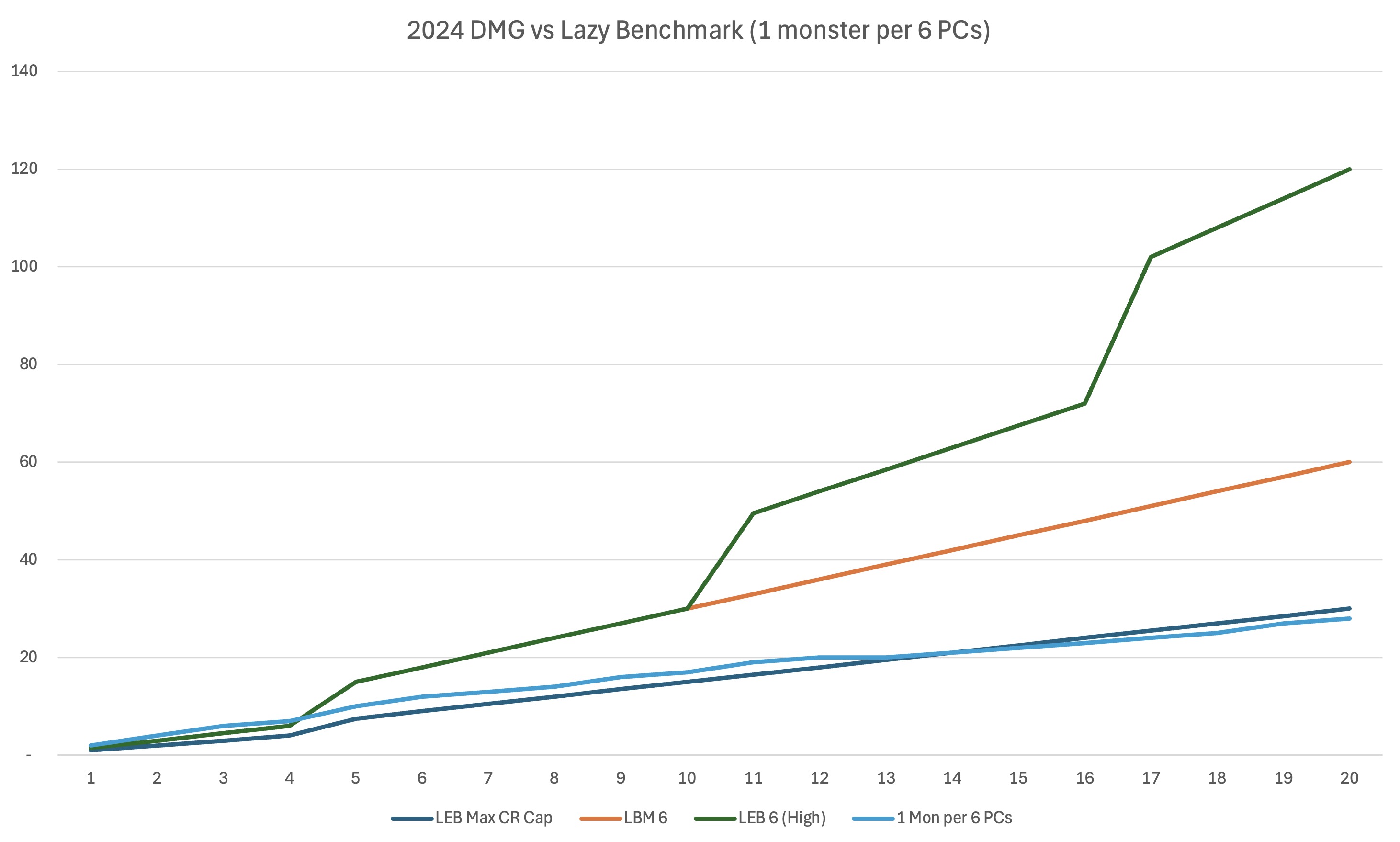
Here the Lazy Encounter Benchmark totally pulls away in both "normal" and "hard" mode. Even at 20th level with six characters, the "hard" version of the 2024 DMG doesn't let characters face a single CR 30 monster.
The Built-In Maximum CR Cap of the 2024 DMG Encounter Building Budget
There's an interesting trick with the D&D 2024 DMG encounter building table. Since it uses experience points instead of challenge ratings, it automatically limits your ability to use single monsters of too high a challenge rating against a given group of characters. For the Lazy Benchmark, we have to add a rule to ensure you don't choose a single monster too high for the characters.
But there's a cost for that advantage – the D&D 2024 DMG rules allows for way more low CR monsters than high CR monsters – potentially producing very dangerous results.
The Push for More Monsters in the Lazy Encounter Benchmark
There's a trick for the Lazy Encounter Benchmark as well. Since the Lazy Encounter Benchmark has a maximum cap for a single monster's CR and still has CRs left over, you're incentivized to add more monsters – the best way to ensure a battle stays challenging.
It's nice that the DMG approach caps the maximum CR for a monster, but that budget eats up all the experience points you'd want to spend on monsters to protect that big boss.
I'm Glad We Have Both
I'm glad the 2024 DMG took the approach it took. First, its still a very usable system – far better than the system in the 2014 DMG. Second, it's not like the ones we have in other 5e systems like Tales of the Valiant, Level Up Advanced 5e, or Flee Mortals. So now we have choices – good choices.
That said, I still prefer the Lazy Encounter Benchmark. I'm glad it is mostly in line with the D&D 2024 DMG encounter guidelines so we won't see weird differences at the table depending on which we choose but I think the benchmark is still far easier to use – you can even memorize it.
I think the 2024 DMG guidelines can be misleading for new GMs. It can produce deadly results when using low CR monsters and easy encounters when facing one big monster with no backup. I think scaling with CR works better than scaling with experience points, even when you have to put a maximum cap on monsters.
The Lazy Encounter Benchmark also helps you to improvise combat encounters in a way the DMG guidelines do not. You're not likely to whip up all the exp values of a bunch of monsters during the game but you know how many CR 5 vampire spawns might be too many if you have a Lazy Encounter Benchmark of 18. That's easy.
Related Articles
- The Lazy Encounter Benchmark – a Simple Measure for D&D and 5e Combat Encounter Deadliness
- What Does Challenge Rating Mean in D&D 5e?
- Building Encounters in Fifth Edition Dungeons & Dragons
Share this article using this link: https://slyflourish.com/2024_dmg_encounter_building_versus_the_lazy_benchmark.html
Subscribe to Sly Flourish
Subscribe to the weekly Sly Flourish newsletter and receive a free adventure generator PDF!
More from Sly Flourish
Sly Flourish's Books
- City of Arches
- Return of the Lazy Dungeon Master
- Lazy DM's Companion
- Lazy DM's Workbook
- Forge of Foes
- Fantastic Lairs
- Ruins of the Grendleroot
- Fantastic Adventures
- Fantastic Locations
Have a question or want to contact me? Check out Sly Flourish's Frequently Asked Questions.
This work is released under a Creative Commons Attribution-NonCommercial 4.0 International license. It allows reusers to distribute, remix, adapt, and build upon the material in any medium or format, for noncommercial purposes only by including the following statement in the new work:
This work includes material taken from SlyFlourish.com by Michael E. Shea available under a Creative Commons Attribution-NonCommercial 4.0 International license.
This site may use affiliate links to Amazon and DriveThruRPG. Thanks for your support!









